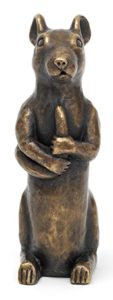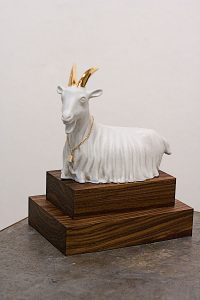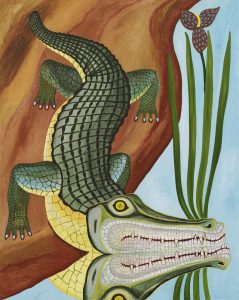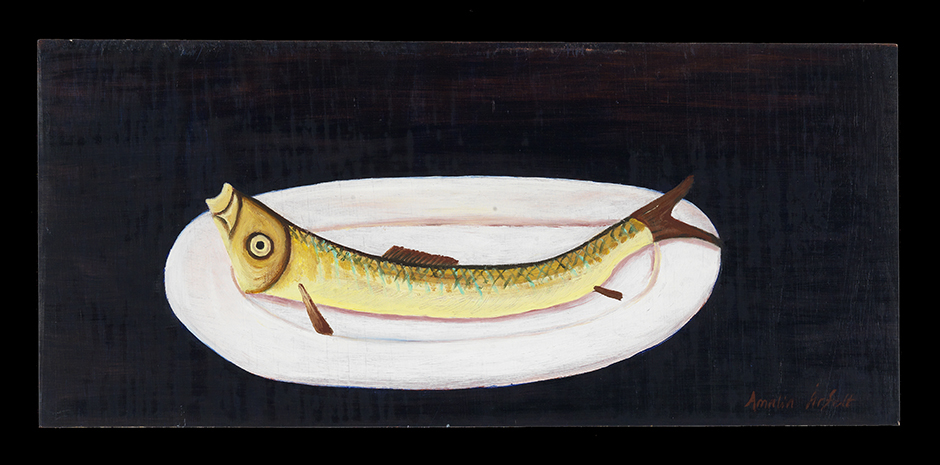This is a translation of the the catalogue text following the exhibition on Konstakademien 2018. Read more about the exhibition here.
By Ann-Marie Tung Hermelin
Translation by Alexei Liss
On a winter night many years ago, a dinner was held at Skeppsholmen at the invitation of the artist, Amalia Årfelt. The reason for the invitation was a painting. We found ourselves seated on each side of Amalia, lined up like disciples of Jesus in Da Vinci’s The Last Supper, except for one person who had been replaced by a pig made of plush, as he was unable to attend. During the preceding autumn, all twelve of us, friends of Amalia, had posed for her and the painting in which we were portrayed together. The painting came first, followed by reality. I was heavily pregnant when Amalia painted me in her studio at the Royal Institute of Art. Now my arms were wrapped around a newborn child as I sat at the dinner table, but I wore the same dress as in the painting. On the table stood meats, cheese, bread, fruit and an abundance of wine. Behind us hung a backdrop reminiscent of the room in Da Vinci’s mural. As we indulged in the food and drink, we soon found ourselves in an almost bacchanal atmosphere. Suddenly the sound of a Spanish guitar enveloped the room. Amalia’s cousin, Benjamin rolled out a wheelchair, in which an artist friend was seated, frantically plucking away at guitar strings, while Karin Mamma danced flamenco, using two tablespoons as castanets. Amalia remained seated in the middle with my infant son firmly planted in her arms. Someone brought out a mandolin, while someone else brought out yet another guitar. All the while, the rest of us stomped, sang and clapped to the beat, dancing away in a synchronised fado.
The gathering reminds me of a banquet which a young Picasso held for Rousseau in his studio in Montmartre during the winter of 1908. The dinner was held both as a quip and as homage to the customs officer and naïve artist, Henri Rousseau. Picasso’s partner, Fernande Olivier hastily cooked paella while Picasso himself bought charcuterie and a large amount of pastries in place of the food they had ordered from a restaurant, only to not have it delivered in time for dinner. The initial reason for the gathering, Rousseau’s painting Portrait of a Woman, which Picasso had bought eight years earlier, rested on several easels among the African masks in a room decorated with pennants and flags plastered with tributes to Rousseau. When the guest of honour arrived in a cab accompanied by the poet, Guillaume Apollinaire, most of the guests were heavily inebriated. Rousseau was placed on a throne like chair in which he sat, deeply touched by the celebratory poems recited in his honour. Meanwhile the candles in the Chinese lanterns above dripped onto his hat forming a pyramid of candlewax. The poet Cremnitz was the first to speak, declaring something along the lines of “this is Rousseau’s painting in which his magic brush tames nature”. In the background, Cubist George Braque played the harmonica while his friends; Pichot and Dali performed a peculiar Spanish dance.
Twenty-three years after the gathering in Skeppsholmen, and one hundred ten years after the banquet held for Rousseau, the commonalities between Henri Rousseau and Amalia Årfelt’s artistry are striking. Årfelt’s panel paintings and sculptures of lions, monkeys, snakes, colourful birds in fantasy landscape among palms and waterbeds with water lilies are displayed in the Art Academy’s gallery. It is a dreamlike place, a utopian paradise that could perhaps be referred to as “Amalien”. Apollinaire’s improvised poem celebrating Rousseau encapsulated one of the aspects that baffled and amused audiences of the time, “your painting captures what you saw in Mexico / red sun in green banana leaves”. Yet Rousseau had never been to Mexico, or in any jungle aside from the botanical garden in Paris and he made no attempt to deny this fact. Rather he insisted on devoting himself to art for art’s sake, with the right to create images without pretences or hidden agendas. The undisguised desire for the creation of images is equally central in Amalia Årfelt’s paintings. The fact that she portrays herself in the center of her own painting, encircled by twelve friends as an analogy for Leonardo da Vinci’s mural painting of Jesus and the twelve disciples, is neither due to delusion of grandeur, nor a commentary on a biblical story, but rather a deliberate way to toy with the image itself. It is a deliberate choice to create and take part in art.
Her aspirations and level of productivity have remained constant since her graduation exhibition at the Royal Institute of Art in 1995. In addition to her paintings, she has principally made herself a name as a sculptor and as the creator of numerous public installations. In 2006, she was commissioned to design the Swedish film award Gullspira representing the goat of the same name in the film ”Barnen från Frostmofjället” (The Children from Frostmofjället), based on the book by Laura Fitinghoff. A few years later, she sculpted a larger scale version of Gullspira, which was placed on a pedestrian street in central Sollefteå. It was inaugurated in 2017.
Animals are fundamental to Amalia Årfelt’s artistry. Gullspira’s mild expression is unmistakable. The animals in her paintings often seem to express ambiguous feelings. Some appear as if they have agreed to be painted, like the lion posing under a palm tree, gazing directly at the beholder, or the crocodile who in a show of vanity exposes all his teeth. They control the image. It is almost like a selfie, in which the animals exhibit sides of themselves, which are neither naturalistic nor beautified. Årfelt does not strive to capture the physical essence of the animals, like the movement of fish in water, i.e. the fish’s inherent fishiness. Instead she aims to transcend the concept of viewing the fish as a fish, but rather as a decorative object and as a carrier of complex feelings. By doing so, the animals appear as unpredictable subjects. Like the sweet petite cat; rather than emphasis its cuteness, its thorny mouth resembles that of an angry piranha, or the flying fish whose blank expression look deliberate, almost feigned, as if they vehemently choose to ignore the viewer.
In her painting, Årfelt works with intense combinations of colour. The sky is bright yellow and the ground is pink. Even with regard to her choices of colour, Årfelt operates on the border between beauty and rawness. In Amalia’s Paradise, the colours are almost palpably delicious. It is as if you can sense its saltiness and sweetness, the crispy taste of light blue, the bitterness of the yellow and the red’s rounded fruitiness. The colours place the spectator in a culinary dream.
The seemingly unconstrained access to an uncensored fantasy, without aesthetic taboos, which permeates Årfelt’s world of imagery, was considered primitive and childish in Rousseau’s day. However, the father of naïve art probably had much greater influence on Picasso’s artistry than vice versa. Towards the end of the banquet, Rousseau bid Picasso farewell with the words: “The two of us are the greatest painters of our time, you in the Egyptian and I in the modern style”, before abandoning the increasingly chaotic gathering.
Those of us who know and have followed Amalia’s artistry over the years know that it emanates from an unusual combination of seldom seen capacity for work and a rare goodness. We know that in every artistic expression there is both humour and seriousness, and ultimately, we see that Amalia Årfelt is Sweden’s finest and foremost living artist working in the naïve style.
Ann-Marie Tung Hermelin
Translation by Alexei Liss






